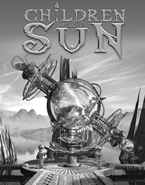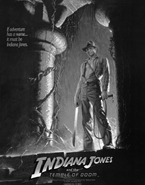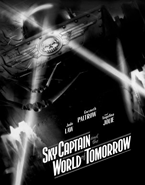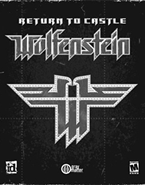 THE GATEHOUSE
THE GATEHOUSE
“Quintessential Dieselpunk”
By N. Ottens (12 February 2008)
This article seeks to establish through examining the following works of dieselpunk fiction, the characteristics quintessential of the genre. Please do note that not all four of these video games and motion pictures might necessary be recognized as being “dieselpunk”—indeed, most were created before the genre came into prominence, yet each feature distinct themes and traits which have come to be associated with it and are therefore worth closer scrutiny.
Children of the Sun
Being the first self-proclaimed dieselpunk video game, Misguided Games’ Children of the Sun should logically serve as a model for all dieselpunk fiction. The game does not, however, feature all familiar characteristics of the genre which later video games and motion pictures would introduce. It is useful nonetheless to examine the elements of Children of the Sun which prompted the game’s designers to label it “dieselpunk” to gain a better understanding of what precisely the genre entails.
The world of Children of the Sun is one of “grit and oil, of dust and mud” in which “arcane engineers take the basic principles of matter and energy and bend them to create towering machines of beauty and danger.”1 Were it not for petroleum sustaining the pre-eminent source of energy, this world would seem very steampunk indeed with technology progressing much faster and further than in the real world. Yet the technology of dieselpunk is more darker, more bizarre, coexisting with magic, “both pervasive.”2
The game also introduces a second dieselpunk distinction: the great emphasis on the hero and his adventures. In the world of Children of the Sun, “the legends of heroes are still sung [...], even as a different breed of soldier is trained with newly developed weapons.”1 This different breed of soldier may forecast the emergency of Nazi “supersoldiers” in later dieselpunk video games, while the hero’s struggle against their modern weapons of war remains a quintessential element of the genre. In this sense, dieselpunk differs particularly from steampunk for where the latter enthusiastically embraces the potential of progress, the former seems typically more ware of its dangers.
Indiana Jones and the Raiders of the Lost Ark
Though the 1981 motion picture is not typically considered dieselpunk, it features nonetheless many of the characteristics of the genre and specifically sought to evoke the sensation of mid-century adventure pulp.3 Fighting Nazis engrossed with paranormal mystery, Indiana Jones must save the world from the domination of evil through a series of perilous adventures which bring the viewer to the farthest outskirts of the world. The motives of the protagonist are entirely honorable, while the evil of his villains is equally unquestioned, their obsession with the occult only meant to greaten the viewer's abhorrence of their purposes.
Raiders of the Lost Ark may seem little anachronistic, yet closer scrutiny reveals some curious technologies besides its paranormal elements—particularly the strangely sophisticated boobytraps of ancient civilizations as well as the futurustic Luftwaffe flying wing inspired by the existing Horten Ho 229 prototype, “chosen by director Steven Spielberg to represent the ominous and advanced state of aeronautics in Hitler’s Germany,”4 make that the film should be considered more than “neo-pulp.&rdquo Since the Indiana Jones franchise was produced before dieselpunk came into prominence, few would be anxious to label it “dieselpunk” yet it might well be considered the first motion picture in the genre.5
Sky Captain and the World of Tomorrow
Typically considered the quintessential dieselpunk installment, Sky Captain and the World of Tomorrow indeed introduces nearly all of the genre’s typical elements to a wider audience for the first time, though many might not have conceived under which genre to categorize the film—if they realized a genre other than science fiction applied to the film at all.
Like Indiana Jones, the plot and protagonist of Sky Captain are greatly inspired by adventure pulp and Golden Age comic book heroes, specifically Buck Rogers and Flash Gordon.6 Director Kerry Conran further cited the 1939 New York World’s Fair as a thematic influence—the optimism about the future despite the looming threat of war apparent from exhibitions like The World of Tomorrow—as well as the works of American delineator Hugh Ferriss upon its urban scenes, whose drawings of immense buildings seem to overshadow the human individual as if embodying the rise of technocratic perception. The aesthetics of dieselpunk fiction in general are accordingly inspired by Futurist art and Art Deco architecture, with the Hindenburg zeppelin mooring at the Empire State Building as epitome of dieselpunk visual style.
Particularly evident in the opening scene of the film is the influence of German Expressionism, specifically the work of Metropolis director Fritz Lang. “Early German cinema was born of just a completely different aesthetic than what we see nowadays,” according to Conran7 who sought to mold in Sky Captain and the World of Tomorrow the enthusiasm about the future inherent of the Pulp Era with the eerie and menace strongly present in Lang’s silent films.
Return to Castle Wolfenstein
Activision's Return to Castle Wolfenstein further explores a world “in which magic and technology are combined”1; set in desolate castle during the more desperate days of World War II, the player takes on the role of an Allied elite soldier sent to investigate rumors surrounding the Paranormal Division of Heinrich Himmler’s SS. Captured and imprisoned in the Castle Wolfenstein, the player must “battle the most horrific creatures ever unleashed” while seeking to escape, facing “zombies brought back from the dead through dark magic and [...] mutants created through twisted science.”8 The ultimate product of this clandestine confunction between occult activity and genetic engineering is depicted in the game to be an Übersoldier, half-man, half-machine, frightening yet strangely fascinating as a glimpse of what might have been.
Though the player in Return to Castle Wolfenstein struggles vigorously against the fretful dreams of Nazi science, the focus is obviously on game-play rather than plot, thus the game’s relevance to dieselpunk lies foremost in its depiction of anachronistic biotechnology and weapons of war rather than the emphasis on heroism and adventure. The adventure in Return to Castle Wolfenstein is more of a dreadful nightmare, quite unlike the buoyant endeavours of Indiana Jones and Sky Captain which hardly ever suggest the possibility of evil triumphing over good. But the game does very much illustrate the menace of machine overtaking man and the always-present perils of progress, which are, of course, overcome by the player through the conventional weapons and wit of a bygone age of jeopardy.
1. Misguided Games, Children of the Sun (2007) (Retrieved through Internet Archive.)
2. M. Bruno, “Interview: Misguided Games’ Lewis Pollak, on Children,” GamingReport.com (2001)
3. Indiana Jones.com, “Making Raiders of the Lost Ark,” Lucasfilm Ltd. (2003) (Retrieved through Internet Archive.)
4. A. Holler, Raiders of the Lost Ark Collector's Album (1981)
5. Retrostacja's “dieselpunk Chronology” lists no earlier films.
6. H. Knowles, “More on Sky Captain & the World of Tomorrow,” Ain't It Cool News (2004)
7. W. Claw, “Sky’s Not the Limit: Kerry Conran on being a pioneer of Tomorrow,” FilmFreaks.net (2004)
8. Activision.com, Return to Castle Wolfenstein
Please select one of the titles listed below to proceed to your article of choice.
• “The darker, dirtier side,” by N. Ottens (2008)
In which we seek to define the genre of dieselpunk by studying its major influences and proposing several characteristics typical of dieselpunk fiction.• “Quintessential Dieselpunk,” by N. Ottens (2008)
In which we further scrutinize the features of the genre by examining a number of its quintessential works of fiction.• “Two Flavors of Dieselpunk,” by N. Ottens (2008)
In which we introduce the two proposed categories of dieselpunk: the optimistic “Ottensian” and the dark, sometimes post-apocalyptic “Piecraftian”.• “What’s Biopunk?,” by N. Ottens (2008)
In which we discuss the history and characteristics of the proposed sub-genre of biopunk to ascertain whether it is a separate genre.


Children of the Sun, Misguided Games (2002)

Raiders of the Lost Ark, Paramount Pictures (1981)

Sky Captain and the World of Tomorrow, Paramount Pictures (2004)

Return to Castle Wolfenstein, Activision (2001)